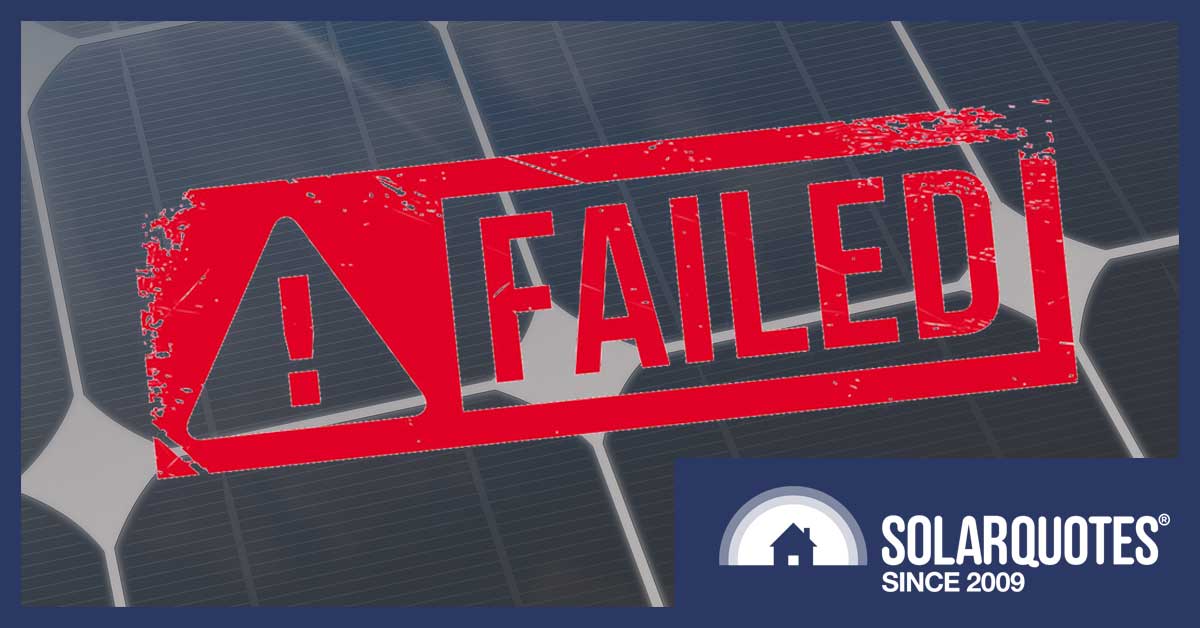
CER Audit: Over 20% Of Solar Installations Are Sub-Standard And More Than 2% Are Dangerous. 0% of installers suspended by CER.
Australia’s Renewable Energy Target or RET was audited last year and a report released last month. It’s a 25,000 word report so I’m not going into everything it covers. There’s way too much detail for that. It’s enormous. If you wanted me to write that many words it would take me all day. Even longer if you wanted them in coherent sentences. But what I will tell you is the report concluded the RET was:
“effectively administered”
except for:
“…the enforcement activities of its investigations unit”.
The lack of enforcement activity is made painfully clear by the following facts:
- Despite Australia suffering from a plague of dodgy installers, not a single one has been suspended by the Clean Energy Regulator for installing sub-standard or dangerous solar systems.
- Of the solar power systems inspected in the first half of 2018, over 20% were given a rating of “sub-standard” while 2.7% were deemed to be “unsafe” and were immediately shut down.
Around one quarter of solar installations failed to make even the piss-weak grade of “adequate”. Installers are required to provide systems that meet Australian standards and only around 8% were able to meet them with only minor deviations. Just 2.5% were rated as “industry best practice”, that is the installation exceeded Australian standards. The largest category was “adequate” which is not disastrous but is not nearly good enough.
You might think with these lousy figures the Clean Energy Regulator will be required to come down like a tonne of bricks on shoddy solar installers. But while the auditor has recommended improvements these changes will take time and, as far as I am aware, no additional funding will be provided for enforcement. This means the onus1 is still on consumers to do their research and protect themselves from solar installers who do crap work or use cheap and nasty hardware. It’s the principle of caveat emptor or let the buyer beware.2
While price is obviously an important consideration for most people, if you buy the cheapest system you can you are almost certain to get a system that is “sub-standard” and you greatly increase your odds of getting one that is “unsafe”.
The RET And The Audit
The part of the Renewable Energy Target most people are familiar with is the financial incentive that lowers the cost of rooftop solar. It is commonly referred to as the “solar rebate” but its real name is SRES and it has a big sister called LRES. Their full names and descriptions are:
- The Small-scale Renewable Energy Scheme or SRES, which reduces the upfront cost of rooftop solar for households and businesses and is being gradually phased out.
- The Large-scale Renewable Energy Scheme or LRES, pays solar farms, wind farms, and other sources of renewable energy for the clean energy they generate. This is also being phased out and payments are expected to be at a low level from 2020 onward. They have already fallen from $85 in April last year to $45 today.
The audit was performed by the Australian National Audit Office or ANAO, which has the job of impartially scrutinizing public accounts. They make sure no funny business is going on and all the money spent comes out of the right buckets.3 You would think the ANAO would be located in Canberra but the internet tells me ANAO is actually in the Philippines and when has the internet ever lied?
Rooftop Solar Inspections
The Clean Energy Regulator is responsible for administrating the RET and performs a “statistically significant” number of solar power system inspections each year.4 While they could have used this site to determine how many inspections would be statistically significant, they instead went and hired a consultant. This demonstrates a commitment to getting things right. It also means they committed to spending money on it, but life is full of trade offs.
Only on-grid systems are inspected even though off-grid homes can benefit from the SRES. From its start at the beginning of 2011 until mid August last year, around 1.9 million solar power systems were installed in Australia. In this time 24,371 systems were inspected, which is a rate of around 1.25%.
Inspections occur 2-18 months after installation. Copies of the inspection report are given to:
- The occupier of the property
- The owner, who is usually but not always an occupant.
- The solar installer, system designer, and agent. (These roles may overlap.)
The original report goes to the Clean Energy Regulator because it would be really stupid if it didn’t.
System Ratings
When an inspector looks over a system he or she will place it into one of these five categories:
The percentage of solar power systems in each category since inspections began are shown below:
The good news is the results are considerably better than the graph makes them appear. This because standards have improved over time and it has become harder for systems to be rated as “complies”. This means the quality of solar installations hasn’t actually declined since 2013.
Dangerous Solar Installations
In 2018 around 2.7% of solar power systems inspected were found to be unsafe. This is higher than the number classified as industry best practice.
In 2015 it was found that 80% of unsafe ratings up to that point in time were due to water in the rooftop DC isolator.5 This is dangerous because water and electricity have a volatile relationship and mixing the two in a little plastic box is a great way to start a fire. While this percentage should have decreased thanks to the improved quality of rooftop DC isolators and increased awareness, it’s still a major cause of problems.6
When an inspector discovers a system is unsafe they must immediately shut it down. Then they must notify all the people who would normally get a copy of the report, but within 24 hours instead of the two months it often takes. They also have to contact the state or territory electrical safety regulator and the Distributed Network Service Provider that locally distributes grid power.
No Installers Have Been Suspended By The CER For Dangerous Installations
The Clean Energy Regulator has the power to suspend solar installers for up to 12 months if three or more inspections rate their work as “sub-standard” or “unsafe”. But at the moment they have not suspended any installers despite there being hundreds who have received ratings of sub-standard or unsafe for every single inspection of their work.
This lack of action by the Clean Energy Regulator is piss-weak. The RET inspections have cost millions of dollars and a huge portion of the potential benefit — shutting down shoddy operators whose solar installations don’t come close to meeting Australian standards or are downright dangerous — has been squandered.
The audit states in section 4.35 that:
“The regulator’s inspection regime would be more effective were it to continuously monitor inspection results for multiple adverse findings against installers and suspend installers where appropriate.”
No shit, Sherlock.
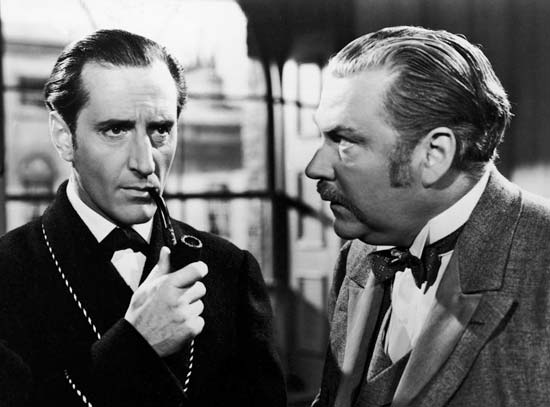
Sherlock Holmes and the mystery of the missing shit.
Solar installers who take a modicum of pride in their work may pull up their socks if they receive a lousy inspection report, but the worst offenders — those who are either completely incompetent or total rip-off merchants — are unlikely to improve unless meaningful sanctions are imposed for lousy results. The Regulator should be smiting the shoddy with its mighty ban hammer rather than letting them off scot-free.

“A DC arc? That’s an instant 12 month ban.” — Thor, the god of solar inspections, only permits Marvel arcs.
While the Clean Energy Regulator hasn’t suspended anyone, 16 months ago they wrote to 35 multiple offenders and told them they could be suspended if they didn’t do their bloody jobs properly — although they probably didn’t use those exact words. So far one of them has had an inspection result that was either sub-standard or unsafe and action is being taken, but apparently nothing has occurred so far.
This is definitely an area that needs improvement.
The Clean Energy Regulator Has Left Discipline To The CEC
So far the Clean Energy Regulator has left all responsibility for spanking wayward solar installers up to the Clean Energy Council (CEC). While the CEC has more than doubled the number of actions they have taken against shoddy installations compared to one year ago, it has always been difficult for an industry body that relies on payments from its members to adequately discipline them. The incentives just don’t line up.
I was going to say the Clean Energy Regulator is like a parent that’s left all family discipline up to their partner, but it’s more like they’ve put it entirely on the most responsible child. The Regulator can work with the CEC on discipline, but they have failed in their duty if they leave it all up to them. Every solar installer needs to know they are not safe if they do crap work, no matter what their position in the organisational body may be or how much funding they contribute to it. The Regulator is spending money to gather the inspection information they need to reign in shoddy installers and it makes no sense not to use it.
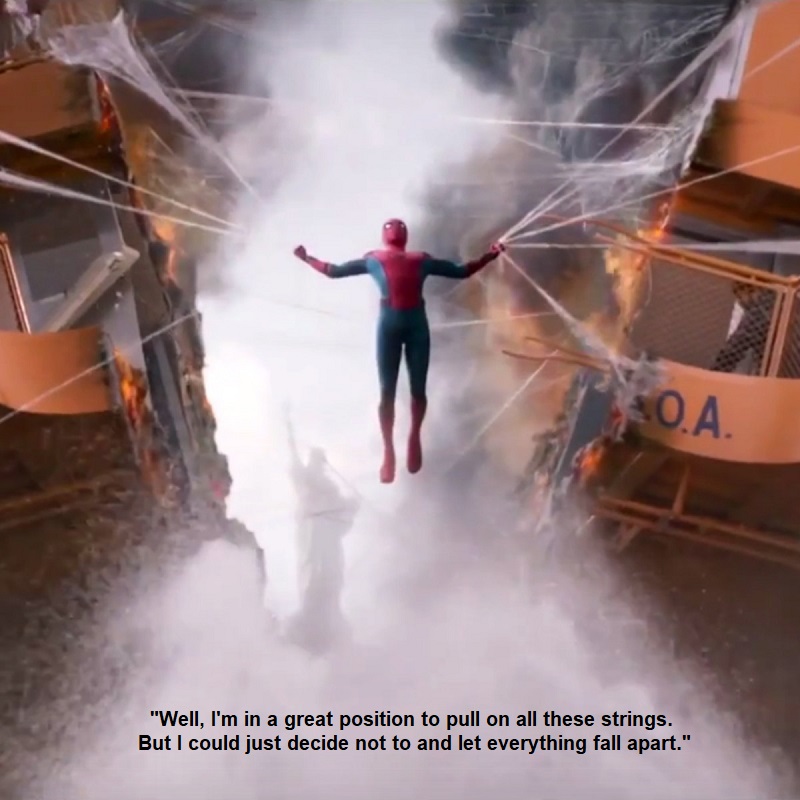
With great regulatory power comes great regulatory responsibility.
Who Watches The Watchers?
The people who perform inspections for the Clean Energy Regulator are meant to be experienced and accredited solar installers with good reputations. Because they are solar installers themselves, this means their own installations can be inspected. So the question arises of who watches the watchers?7 The answer is they watch each other.
From the start of 2016 to June 2018 there were 6,543 inspections performed by 1,676 different installers. A total of 45.8% of these solar installers had one or more of their solar installations rated as sub-standard or unsafe. Of them 157 had every single one of their inspected systems rated as sub-standard or unsafe. So a lot of inspections were done by people who were pretty bad at installing solar power systems themselves.
I Expect Some Improvement
Now the audit is complete I expect the RET will be administered more effectively and the average quality of solar installations will continue to rise. But I’m not expecting any huge improvements. This is because if the RET had been intended to ensure almost every installation met Australian standards it would have been given enough funding to achieve this from the start.8 Instead, it was only given enough funding to reduce the the number of shoddy and dangerous solar installations. Regrettably, the resources they had were not used as effectively as they could have been.
I haven’t found any mention in the audit of an increase in the RET’s funding for inspections and enforcement. This means the suggestions for improvement resulting from the audit are likely to only involve using the funds they currently have more effectively. This means it’s still up to consumers to do their research and “caveat emptor” or “uti solisquotes” or whatever Latin phrases may be required.
Footnotes
- The word “onus” is Latin for load. So why didn’t I just say “load”? Because I’m a Latin lover. ↩
- Caveat emptor is a Latin phrase that acquired the meaning “Let the buyer beware” because the Roman Empire had many underground shops in the cave at Emptor where the storekeepers were always trying to rip customers off and get people to believe things that weren’t true. ↩
- Government work is 90% meeting the needs of the Australian people and 10% making sure the funds used were from the correct bucket. ↩
- These are not the only inspections carried out in Australia. For example, Victoria requires all new rooftop solar systems be inspected. But their inspections are far less comprehensive than what the Clean Energy Regular carries out. ↩
- This is a switch that can used to cut off the flow of current through the panels. ↩
- New Zealand doesn’t have a problem with rooftop DC isolators because when they photocopied Australia’s standards — I mean, when we jointly developed them — they decided they weren’t needed. But I guess Australians are just too careful to do without a safety feature, no matter how dangerous it may be. How things change. At Gallipoli the Turks preferred to fight Australians rather than New Zealanders because Australians weren’t as careful when it came to ducking. ↩
- In Latin this is “Quis custodiet ipsos custodes?” Its literal meaning is, “Quiz! Does a custard diet contain custard?” The phrase obtained its modern meaning due to Emperor Nero instructing his fattest Senators to help him watch his weight. ↩
- While it would be nice to put an end to all dodgy installations, this may not be practical. As the financial expert Dan Davies explains in his new book on fraud that I recently photocopied, “The optimal level of fraud is unlikely to be zero.” This is because the cost of stamping out all fraud would be greater than the cost of the harm caused by a low background level of dishonest activity. ↩

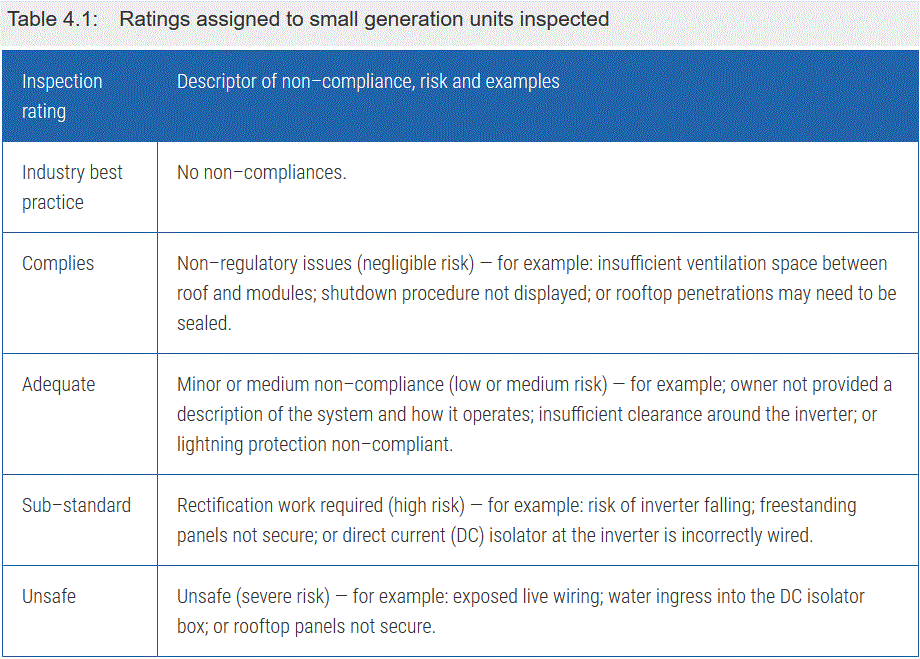
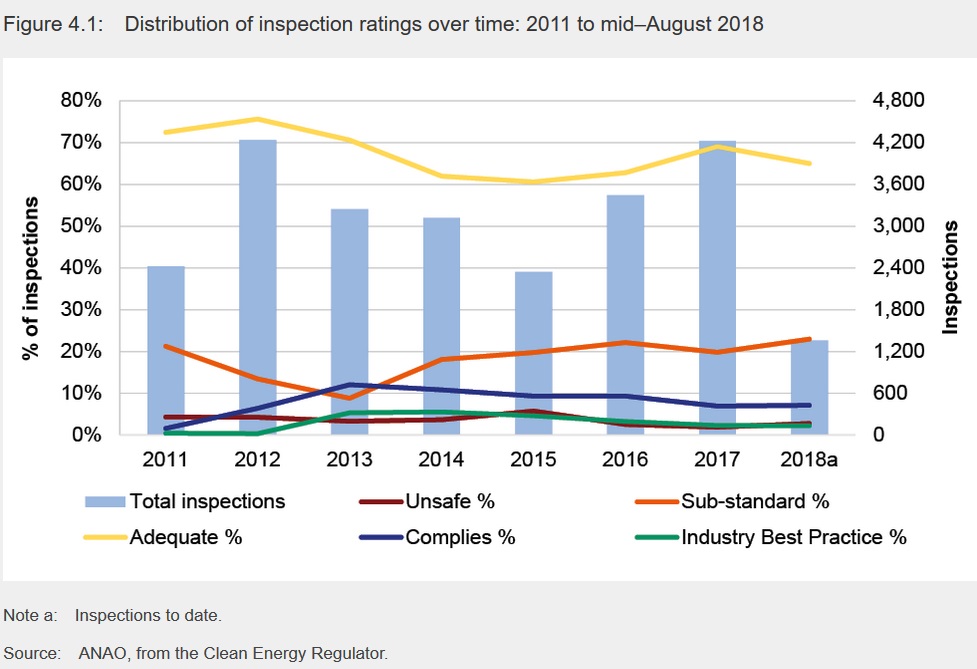

 RSS - Posts
RSS - Posts



In Queensland any customer that receives a negative report can pass it on to the Electrical Safety Office who take these things very seriously and in NSW it is Fair Trading the Fair Trading web site also has a list of Solar Installers who have been Prosecuted
So .. remind me what the CEC does again?
If the status of “CEC registered installers” means zero … remind why STCs are aligned with the CEC.
Personally, I’d suggest a 3 strikes and you’re out system, with the understanding that only 1.25% of systems have been inspected, this implies that each install is representative of 80x installations.
First time: 3x unsafe installs – 1 month suspension + 1 strike + mandatory training course on industry best practice.
Second time: 3x unsafe installs – 3 months suspension + 1 strike + mandatory training course on industry best practice.
Third time: 3x unsafe installs – CEC suspension permanently.
In regards to Sub-Standard installs.
Introduction of CEC Gold / CEC Silver / CEC Bronze status’s might be an idea:
– Bronze status being assigned to any installer where “sub standard” installs have been picked up with >5% “sub standard” installs.
– Silver status can be assigned where +80% inspections have received “complies” or “industry best practice”, without any rating below “adequate”
– Gold status can be assigned where All inspections have received “complies” or “industry best practice”.
This would let potential customers know the quality of their installer, and would provide an opportunity for Gold/Silver installers to charge a slight premium for their superior work.
Probably a pipe dream, since the CEC can’t even wrangle the time to cancel the membership status of installers with consistent extreme installation failings.
Good article from someone that was’bitten’ – too many ”cowboys” and there seem to bee any Regulator. i am going though an upgrading of some old panels and even this firm was trying to talk me out of continuing with my monitoring software/package
Have you checked your recommended installers are still cleanskins Ron so we can feel confident getting a quote?
So many con men out there.
Definitely. Finn goes through a lot of effort to make sure we will only refer reliable installers who do high quality work.
Hi Clive,
No installers are perfect – and the installers we refer will sometimes fail inspections too.
But I try really hard to only refer installers who – when they drop the ball – will quickly rectify any issues without fuss.
So whilst we cannot remove all risk from getting solar – I really do believe that going solar via an SQ referral is much lower risk than going in blind.
Also – if there is a problem with a SQ referred installer my team is happy to step in to make things right if there is an issue. This is rare – as these installers usually do the right thing without being pinged by us.
Occasionally I mess up and accept an installer who turns out to be not up to scratch – our feedback loop of reading all reviews helps us weed them out quickly.
Hope That Helps,
Finn
Excellent Article. Thanks for sharing.
Totally agree with #6
Many of these faults relate to rooftop isolators which by all accounts are meant as a safety device for fire fighters.
I have been told fire fighters never use them.
You make a very good argument for what I’ve been saying since Moses realised he was missing a bit off the end of his snag. DO IT YOURSELF ~ or get a half-witted chimpanzee to do it for you. I’ve never yet ~ in 50 years of DIY in all sorts of fields ~ known a DIYer who hasn’t ‘overbuilt’ whatever he’s turned his hand to. (eg. never heard of an owner-installed solar system burning down a house; whereas most housefires are caused by an electrical fault installed by a ‘qualified electrician’.)
And in this day of freely-available advice about just about EVERYTHING, whatever info./cross-reference you might need about the standard of components from sources, for example, can be found online from people who don’t have an axe to grind.
Yep. I fired three qualified electricians who were supposed to rewire my home in the early ’80’s plus add a lot of fully zoned (and earth leakage protected) wiring to two new builds on the same block. All three reckoned I was doing it in a too expensive, unnecessary fashion. Considering the computer workshop part of the build could have over $1M of gear in it at any one time, I “kinda disagreed”. To rub salt in the wound, the standard of their work was simply appalling.
I ended up doing all the work myself and then getting applying to get the appropriate certification by the current authority. He reckoned I should work in his trade as it was among the best installs he had ever seen – and promptly certified it.
My “building things” trade – mainly high speed computer servers. Wiring to that precision was obviously way higher than the trades standard at the time.
IMO, the West has too many house fires caused by poor wiring standards and too many dodgy “electricians” who cannot even meet such poor standards.
ps. The only problem with installing tyour own solar system is that the law requires that connection to the grid requires your system be installed by a ‘recognised professional’ ~ no matter how incompetent.
That, of course, supports my other basic argument —–> go stand-alone. Apart from other benefits you’ll save a shitload of money: both in the installation AND in ongoing costs such as the ‘connection charge’.
We need independent auditors , not electricians inspecting other electricians work. .. conflict of interest??
Seems difficult to get answers in this industry for me, is their rules in relation to proximity of inverters for 256 kw system in relation to residence, we have this size unit in car park two floors beneath us and have queried EMF but was brushed off saying emits no more than a normal house by electrician installing, is this correct? the cabling was also run some 40 metres away from roof point solar panels installed which also seems contry to what I have read.
It should emit no more EMF than any other electrical installation. It has to meet Australian standards for EMF emission. Having the inverter 40 meters from the panels would be bad for residential solar, but this system is very large and may operate at a higher voltage so the length of the cables is probably considered acceptable.